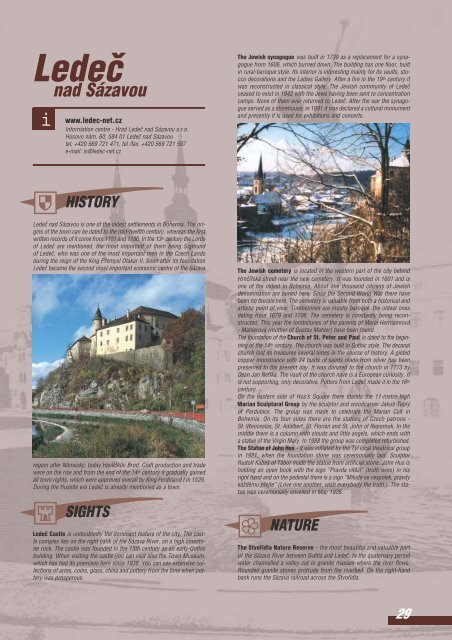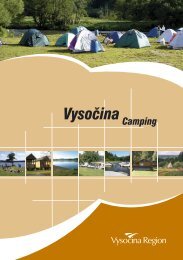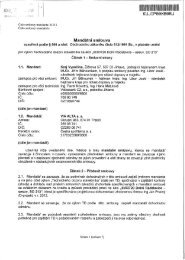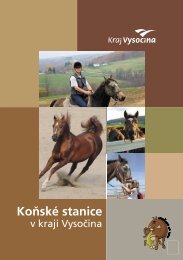history - Extranet
history - Extranet
history - Extranet
- No tags were found...
You also want an ePaper? Increase the reach of your titles
YUMPU automatically turns print PDFs into web optimized ePapers that Google loves.
Ledeãnad Sázavouiwww.ledec-net.czInformation centre - Hrad Ledeã nad Sázavou s.r.o.Husovo nám. 60, 584 01 Ledeã nad Sázavoutel. +420 569 721 471, tel /fax. +420 569 721 507e-mail: is@ledec-net.czThe Jewish synagogue was built in 1739 as a replacement for a synagoguefrom 1606, which burned down. The building has one floor, builtin rural-baroque style. Its interior is interesting mainly for its vaults, stuccodecorations and the Ladies Gallery. After a fire in the 19 th century itwas reconstructed in classical style. The Jewish community of Ledeãceased to exist in 1942 with the Jews having been sent to concentrationcamps. None of them ever returned to Ledeã. After the war the synagogueserved as a storehouse, in 1991 it was declared a cultural monumentand presently it is used for exhibitions and concerts.HISTORYLedeã nad Sázavou is one of the oldest settlements in Bohemia. The originsof the town can be dated to the mid-twelfth century, whereas the firstwritten records of it come from 1181 and 1186. In the 13 th century the Lordsof Ledeã are mentioned, the most important of them being Sigmundof Ledeã, who was one of the most important men in the Czech Landsduring the reign of the King Pfiemysl Otakar II. Soon after its foundationLedeã became the second most important economic centre of the Sázavaregion after Nûmeck˘, today HavlíãkÛv Brod. Craft production and tradewere on the rise and from the end of the 14 th century it gradually gainedall town rights, which were approved overall by King Ferdinand I in 1526.During the Hussite era Ledeã is already mentioned as a town.SIGHTSLedeã Castle is undoubtedly the dominant feature of the city. The castlecomplex lies on the right bank of the Sázava River, on a high limestonerock. The castle was founded in the 13th century as an early-Gothicbuilding. When visiting the castle you can visit also the Town Museum,which has had its premises here since 1938. You can see extensive collectionsof arms, coins, glass, china and pottery from the time when potterywas prosperous.The Jewish cemetery is located in the western part of the city behindHrnãífiská street near the new cemetery. It was founded in 1601 and isone of the oldest in Bohemia. About one thousand citizens of Jewishdenomination are buried here. Since the Second World War there havebeen no burials here. The cemetery is valuable from both a historical andartistic point of view. Tombstones are mostly baroque, the oldest onesdating from 1679 and 1706. The cemetery is constantly being reconstructed.This year the tombstones of the parents of Marie Hermannová- Mahlerová (mother of Gustav Mahler) have been found.The foundation of the Church of St. Peter and Paul is dated to the beginningof the 14 th century. The church was built in Gothic style. The decanalchurch lost its treasures several times in the course of <strong>history</strong>. A gildedcopper monstrance with 24 busts of saints made from silver has beenpreserved to the present day. It was donated to the church in 1773 byDean Jan Neffka. The vault of the church nave is a European curiosity. Itis not supporting, only decorative. Potters from Ledeã made it in the 16 thcentury.On the eastern side of Hus’s Square there stands the 11-metre highMarian Sculptural Group by the sculptor and woodcarver Jakub Tepl˘of Pardubice. The group was made to celebrate the Marian Cult inBohemia. On its four sides there are the statues of Czech patrons -St. Wenceslas, St. Adalbert, St. Florian and St. John of Nepomuk. In themiddle there is a column with clouds and little angels, which ends witha statue of the Virgin Mary. In 1988 the group was completed refurbished.The Statue of John Hus - it was initiated by the Tyl local theatrical groupin 1921, when the foundation stone was ceremonially laid. SculptorRudolf Kabe‰ of Tábor made the statue from artificial stone. John Hus isholding an open book with the sign ”Pravda vítûzí” (truth wins) in hisright hand and on the pedestal there is a sign ”Milujte se vespolek, pravdykaÏdému pfiejte” (Love one another, wish everybody the truth.). The statuewas ceremonially unveiled in May 1926.NATUREThe Stvofiidla Nature Reserve - the most beautiful and valuable partof the Sázava River between Svûtlá and Ledeã. In the quaternary periodwater channelled a valley cut in granite masses where the river flows.Rounded granite stones protrude from the riverbed. On the right-handbank runs the Sázava railroad across the Stvofiidla.29
















